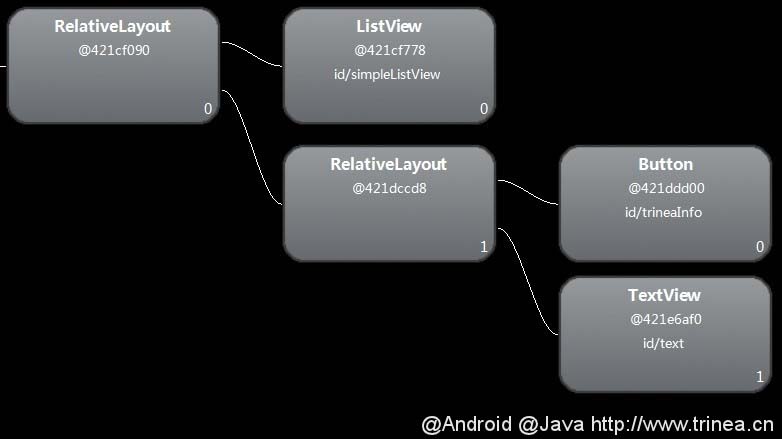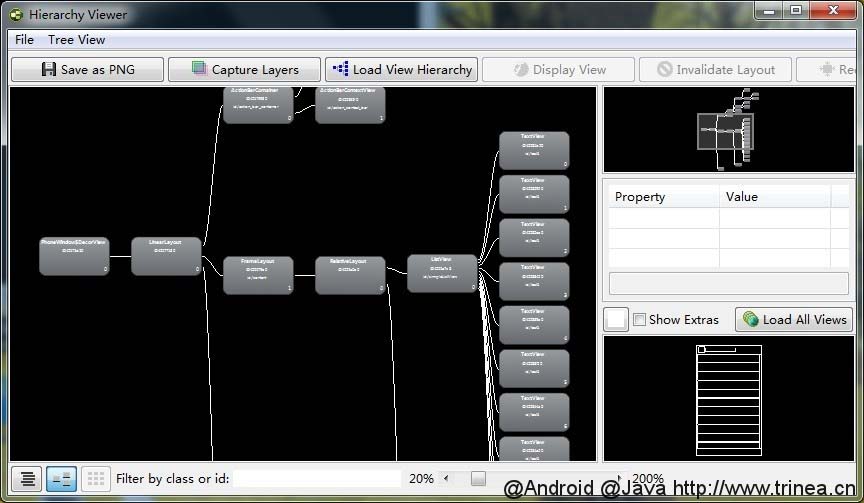来源:http://www.trinea.cn/android/layout-performance/
本文为Android性能优化的第二篇——布局优化,主要介绍使用抽象布局标签(include, viewstub, merge)、去除不必要的嵌套和View节点、减少不必要的infalte及其他Layout方面可调优点,顺带提及布局调优相关工具(hierarchy viewer和lint)。
性能优化专题已完成五部分:
性能优化总纲——性能问题及性能调优方式
性能优化第三篇——Java(Android)代码优化
性能优化第二篇——布局优化
性能优化第一篇——数据库性能优化
性能优化实例
1、抽象布局标签
(1) <include>标签
include标签常用于将布局中的公共部分提取出来供其他layout共用,以实现布局模块化,这在布局编写方便提供了大大的便利。
下面以在一个布局main.xml中用include引入另一个布局foot.xml为例。main.mxl代码如下:
1 <?xml version="1.0" encoding="utf-8"?> 2 <RelativeLayout xmlns:android="http://schemas.android.com/apk/res/android" 3 android:layout_width="match_parent" 4 android:layout_height="match_parent" > 5 6 <ListView 7 android:id="@+id/simple_list_view" 8 android:layout_width="match_parent" 9 android:layout_height="match_parent" 10 android:layout_marginBottom="@dimen/dp_80" /> 11 12 <include layout="@layout/foot.xml" /> 13 14 </RelativeLayout>
其中include引入的foot.xml为公用的页面底部,代码如下:
1 <?xml version="1.0" encoding="utf-8"?> 2 <RelativeLayout xmlns:android="http://schemas.android.com/apk/res/android" 3 android:layout_width="match_parent" 4 android:layout_height="match_parent" > 5 6 <Button 7 android:id="@+id/button" 8 android:layout_width="match_parent" 9 android:layout_height="@dimen/dp_40" 10 android:layout_above="@+id/text"/> 11 12 <TextView 13 android:id="@+id/text" 14 android:layout_width="match_parent" 15 android:layout_height="@dimen/dp_40" 16 android:layout_alignParentBottom="true" 17 android:text="@string/app_name" /> 18 19 </RelativeLayout>
<include>标签唯一需要的属性是layout属性,指定需要包含的布局文件。可以定义android:id和android:layout_*属性来覆盖被引入布局根节点的对应属性值。注意重新定义android:id后,子布局的顶结点i就变化了。
(2) <viewstub>标签
viewstub标签同include标签一样可以用来引入一个外部布局,不同的是,viewstub引入的布局默认不会扩张,即既不会占用显示也不会占用位置,从而在解析layout时节省cpu和内存。
viewstub常用来引入那些默认不会显示,只在特殊情况下显示的布局,如进度布局、网络失败显示的刷新布局、信息出错出现的提示布局等。
下面以在一个布局main.xml中加入网络错误时的提示页面network_error.xml为例。main.mxl代码如下:
1 <?xml version="1.0" encoding="utf-8"?> 2 <RelativeLayout xmlns:android="http://schemas.android.com/apk/res/android" 3 android:layout_width="match_parent" 4 android:layout_height="match_parent" > 5 6 …… 7 <ViewStub 8 android:id="@+id/network_error_layout" 9 android:layout_width="match_parent" 10 android:layout_height="match_parent" 11 android:layout="@layout/network_error" /> 12 13 </RelativeLayout>
其中network_error.xml为只有在网络错误时才需要显示的布局,默认不会被解析,示例代码如下:
1 <?xml version="1.0" encoding="utf-8"?> 2 <RelativeLayout xmlns:android="http://schemas.android.com/apk/res/android" 3 android:layout_width="match_parent" 4 android:layout_height="match_parent" > 5 6 <Button 7 android:id="@+id/network_setting" 8 android:layout_width="@dimen/dp_160" 9 android:layout_height="wrap_content" 10 android:layout_centerHorizontal="true" 11 android:text="@string/network_setting" /> 12 13 <Button 14 android:id="@+id/network_refresh" 15 android:layout_width="@dimen/dp_160" 16 android:layout_height="wrap_content" 17 android:layout_below="@+id/network_setting" 18 android:layout_centerHorizontal="true" 19 android:layout_marginTop="@dimen/dp_10" 20 android:text="@string/network_refresh" /> 21 22 </RelativeLayout>
在java中通过(ViewStub)findViewById(id)找到ViewStub,通过stub.inflate()展开ViewStub,然后得到子View,如下:
1 private View networkErrorView; 2 3 private void showNetError() { 4 // not repeated infalte 5 if (networkErrorView != null) { 6 networkErrorView.setVisibility(View.VISIBLE); 7 return; 8 } 9 10 ViewStub stub = (ViewStub)findViewById(R.id.network_error_layout); 11 networkErrorView = stub.inflate(); 12 Button networkSetting = (Button)networkErrorView.findViewById(R.id.network_setting); 13 Button refresh = (Button)findViewById(R.id.network_refresh); 14 } 15 16 private void showNormal() { 17 if (networkErrorView != null) { 18 networkErrorView.setVisibility(View.GONE); 19 } 20 }
在上面showNetError()中展开了ViewStub,同时我们对networkErrorView进行了保存,这样下次不用继续inflate。这就是后面第三部分提到的减少不必要的infalte。
viewstub标签大部分属性同include标签类似。
上面展开ViewStub部分代码
1 ViewStub stub = (ViewStub)findViewById(R.id.network_error_layout); 2 networkErrorView = stub.inflate();
也可以写成下面的形式
1 View viewStub = findViewById(R.id.network_error_layout); 2 viewStub.setVisibility(View.VISIBLE); // ViewStub被展开后的布局所替换 3 networkErrorView = findViewById(R.id.network_error_layout); // 获取展开后的布局
效果一致,只是不用显示的转换为ViewStub。通过viewstub的原理我们可以知道将一个view设置为GONE不会被解析,从而提高layout解析速度,而VISIBLE和INVISIBLE这两个可见性属性会被正常解析。
(3) <merge>标签
在使用了include后可能导致布局嵌套过多,多余不必要的layout节点,从而导致解析变慢,不必要的节点和嵌套可通过hierarchy viewer(下面布局调优工具中有具体介绍)或设置->开发者选项->显示布局边界查看。
merge标签可用于两种典型情况:
a. 布局顶结点是FrameLayout且不需要设置background或padding等属性,可以用merge代替,因为Activity内容试图的parent view就是个FrameLayout,所以可以用merge消除只剩一个。
b. 某布局作为子布局被其他布局include时,使用merge当作该布局的顶节点,这样在被引入时顶结点会自动被忽略,而将其子节点全部合并到主布局中。
以(1) <include>标签的示例为例,用hierarchy viewer查看main.xml布局如下图:

可以发现多了一层没必要的RelativeLayout,将foot.xml中RelativeLayout改为merge,如下:
1 <?xml version="1.0" encoding="utf-8"?> 2 <merge xmlns:android="http://schemas.android.com/apk/res/android" 3 android:layout_width="match_parent" 4 android:layout_height="match_parent" > 5 6 <Button 7 android:id="@+id/button" 8 android:layout_width="match_parent" 9 android:layout_height="@dimen/dp_40" 10 android:layout_above="@+id/text"/> 11 12 <TextView 13 android:id="@+id/text" 14 android:layout_width="match_parent" 15 android:layout_height="@dimen/dp_40" 16 android:layout_alignParentBottom="true" 17 android:text="@string/app_name" /> 18 19 </merge>
运行后再次用hierarchy viewer查看main.xml布局如下图:

这样就不会有多余的RelativeLayout节点了。
2、去除不必要的嵌套和View节点
(1) 首次不需要使用的节点设置为GONE或使用viewstub
(2) 使用RelativeLayout代替LinearLayout
大约在Android4.0之前,新建工程的默认main.xml中顶节点是LinearLayout,而在之后已经改为RelativeLayout,因为RelativeLayout性能更优,且可以简单实现LinearLayout嵌套才能实现的布局。
4.0及以上Android版本可通过设置->开发者选项->显示布局边界打开页面布局显示,看看是否有不必要的节点和嵌套。4.0以下版本可通过hierarchy viewer查看。
3、减少不必要的infalte
(1) 对于inflate的布局可以直接缓存,用全部变量代替局部变量,避免下次需再次inflate
如上面ViewStub示例中的
1 if (networkErrorView != null) { 2 networkErrorView.setVisibility(View.VISIBLE); 3 return; 4 }
(2) ListView提供了item缓存,adapter getView的标准写法,如下:
1 @Override 2 public View getView(int position, View convertView, ViewGroup parent) { 3 ViewHolder holder; 4 if (convertView == null) { 5 convertView = inflater.inflate(R.layout.list_item, null); 6 holder = new ViewHolder(); 7 …… 8 convertView.setTag(holder); 9 } else { 10 holder = (ViewHolder)convertView.getTag(); 11 } 12 } 13 14 /** 15 * ViewHolder 16 * 17 * @author trinea@trinea.cn 2013-08-01 18 */ 19 private static class ViewHolder { 20 21 ImageView appIcon; 22 TextView appName; 23 TextView appInfo; 24 }
关于ListView缓存原理可见Android ListView缓存机制。
4、其他点
(1) 用SurfaceView或TextureView代替普通View
SurfaceView或TextureView可以通过将绘图操作移动到另一个单独线程上提高性能。
普通View的绘制过程都是在主线程(UI线程)中完成,如果某些绘图操作影响性能就不好优化了,这时我们可以考虑使用SurfaceView和TextureView,他们的绘图操作发生在UI线程之外的另一个线程上。
因为SurfaceView在常规视图系统之外,所以无法像常规试图一样移动、缩放或旋转一个SurfaceView。TextureView是Android4.0引入的,除了与SurfaceView一样在单独线程绘制外,还可以像常规视图一样被改变。
(2) 使用RenderJavascript
RenderScript是Adnroid3.0引进的用来在Android上写高性能代码的一种语言,语法给予C语言的C99标准,他的结构是独立的,所以不需要为不同的CPU或者GPU定制代码代码。
(3) 使用OpenGL绘图
Android支持使用OpenGL API的高性能绘图,这是Android可用的最高级的绘图机制,在游戏类对性能要求较高的应用中得到广泛使用。
Android 4.3最大的改变,就是支持OpenGL ES 3.0。相比2.0,3.0有更多的缓冲区对象、增加了新的着色语言、增加多纹理支持等等,将为Android游戏带来更出色的视觉体验。
(4) 尽量为所有分辨率创建资源
减少不必要的硬件缩放,这会降低UI的绘制速度,可借助Android asset studio
5、布局调优工具
(1) hierarchy viewer
hierarchy viewer可以方便的查看Activity的布局,各个View的属性、measure、layout、draw的时间,如果耗时较多会用红色标记,否则显示绿色。
hierarchy viewer.bat位于<sdk>/tools/目录下。使用可见:Using Hierarchy Viewer , 示例图如下:

标注: hierarchy viewer目前在发布的商业版上处于安全考虑已经不可用:
To preserve security, Hierarchy Viewer can only connect to devices running a developer version of the Android system
可参考http://lxfgrace.iteye.com/blog/1821869方案,just try
(2) layoutopt
layoutopt是一个可以提供layout及其层级优化提示的命令行,在sdk16以后已经被lint取代,在Windows->Show View->Other->Android->Lint Warnings查看lint优化提示,lint具体介绍可见Improving Your Code with lint。
来源:http://www.trinea.cn/android/layout-performance/